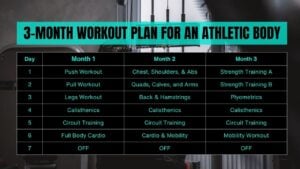If you’re planning to start high-intensity interval training (HIIT) but are not sure what you can expect from it, this article can help you.
Here, I’ve shared various pros and cons of HIIT (based on research and surveys) that will motivate you to start interval training and inform you of its risks at the same time.
Knowing the advantages and disadvantages will help you and your clients utilize high-intensity interval training properly, safely, and effectively.
What is HIIT?
High-Intensity Interval Training (HIIT) is one of the best fitness programs designed to work on the entire body in a shorter time. It involves performing exercises at a fast pace, followed by a short recovery period.
Let’s understand with an example.
Assume five exercises in a circuit: squats, burpees, jumping jacks, high knees, and crunches.
Here’s how you can complete that circuit:
- Do as many squats as possible in 30 seconds, then rest for 30 seconds.
- Do as many burpees as you can in 30 seconds, take 30 seconds rest.
- Do jumping jacks for 30 seconds, then rest for 30 seconds.
- Do high-knees for 30 seconds, then rest for 30 seconds.
- Complete as many crunches as possible in 30 seconds, then rest for 30 seconds.
That’s one round. You can do as many rounds as you like and include as many exercises as you wish in one circuit.
HIIT workouts are short, intense bursts and help you boost your overall performance. You can combine bodyweight aerobic exercises as well as dumbbell training in a HIIT program.
Bodyweight exercises are quicker and more suitable for interval training programs.
Benefits of High-Intensity Interval Training (HIIT)

- More Calories Quickly
- Afterburn Affect
- Increase Weight Loss
- Strengthen Muscles and Bones
- Improve Heart Health
- Reduce Blood Pressure
- Improve Breathing Capacity and Lung Functions
- Boost Stamina
- Improve Athletic Performace
- Enhance Quality of Life
- Fight Against Ageing
- Don’t require much equipment
- Time Efficient
- HIIT reduces Blood Sugar
- Challenging and exciting
1. Burns More Calories
Interval training is an excellent way to torch plenty of calories in a short time compared to traditional cardio and resistance training.1 Caloric expenditure of aerobic, resistance, or combined high-intensity interval training using a hydraulic resistance system in healthy men – National Institute of Health Database. It can help you burn as many as 200-300 calories in just 20 minutes.
It is great for those who want to feel the maximum heat in a limited time.
2. Afterburn Effect
The “Afterburn” effect means your body continues to burn calories even after your exercise is over. Generally, It lasts for a period of 2 to 24 hours, deepening your fitness level.
High-intensity interval training keeps your body temperature high and annihilates calories even after hours of workout.
It is great for those who want to stay in a calorie deficit and shed some excess fats.
3. Increase Weight Loss
Intense burst interval training is an inexpensive and effective way to speed up weight loss and build a lean physique.
Many studies have been done on this subject; let’s see what they have revealed.
1) Interval training decreases body fat percentage by 2 percent in 8-12 weeks of training without changing diet and lifestyle – confirmed in a study published by the British Journal of Sports Medicine.2 Is interval training the magic bullet for fat loss? A systematic review and meta-analysis comparing moderate-intensity continuous training with high-intensity interval training (HIIT) – British Journal of Sports Medicine
2) HIIT helps reduce subcutaneous and abdominal fat more than the other types of exercise, like steady-state cardio and resistance training.
The same study revealed that 15 overweight women who followed the HIIT program and ate a healthy diet lost 2.6 Kg subcutaneous fat in 15 weeks.
3) Performing 20 minutes of HIIT three times a week for 12 weeks reduced approximately 2 kg or 4.4 pounds of body fat in young males.3 The effect of high-intensity intermittent exercise on body composition of overweight young males – Journal of Obesity
However, workouts alone can’t help you lose weight unless you manage your calorie consumption.
Out of several factors, a calorie deficit is the primary reason for weight loss.
Eating low-calorie foods and working out consistently will help you stay in a calorie deficit.
4. Strengthen Muscles and Bones
Short burst interval training isn’t the best way to build muscle mass but it increases the fat-free mass after the training of 12 weeks (three times a week) in young people – as shown in the above study (4).
HIIT may not help you gain muscle, but it develops skeletal muscles, increases bone density, and improves muscle coordination.
5. Improve Heart Health
If you want to enhance your heart health, you can do interval training.
A study showed that even a short session of HIIT improves cardiovascular health and decreases the chances of heart failure.4 High-intensity interval training for health benefits and care of cardiac diseases – The key to an efficient exercise protocol – World Journal of Cardiology
The short interval training stimulates VO2peak, which helps your heart, lungs, and muscles to utilize oxygen efficiently during the workouts. The better the VO2peak, the more optimum your heart functions.
However, if you have any problem related to the heart, please seek medical assistance before starting the HIIT program.
6. Control Blood Pressure
HIIT can reduce blood pressure, especially in overweight and obese individuals who often suffers from high blood pressure problem.5 Effects of high-intensity interval training on blood pressure in hypertensive subjects – National Library of Medicine Database
It significantly reduces systolic blood pressure in the hypertensive group in just eight weeks of training.
7. Enhance Breathing Capacity and Lung Function
Among the several benefits of HIIT, improving lung function is also an important one.
In a study, some researchers selected 15 physically active men for two different training programs for four weeks (3 days a week).6 Effects of high-intensity interval training on pulmonary function – European Journal of Applied Physiology7
Out of 15, 8 were assigned to do High-Intensity Interval Training, and the rest were selected for Endurance Training.
HIIT group performed stationary bicycling at 90% of their maximum heart rate. They did a total of 5 rounds, 1-min cycling followed by a 3-min recovery period.
On the other hand, The ET group cycled for 45 min continuously at 60-70% of their maximum heart rate.
In the middle and the end of the training, both groups performed a five-mile run.
The study demonstrated that HIIT significantly improves respiratory muscle strength compared to endurance training in a short amount of time.
8. Boost VO2 max
Short bursts of interval training improve your body’s ability to use the maximum amount of O2 (oxygen) during the workout.8 Effectiveness of High-Intensity Interval Training (HIT) and Continuous Endurance Training for VO2max Improvements: A Systematic Review and Meta-Analysis of Controlled Trials – Sports Medicine Auckland (N.Z)
It allows you to perform a myriad of exercises efficiently so you can have a satisfying training session.
9. Improve Athletic Performance
If you’re an athlete, HIIT can be beneficial for you. Several studies have demonstrated that short burst intense workouts, such as sprinting, jumping rope, and jump squats, build up athletic performance.
10. Enhances Quality of Life
Working out 20 minutes of HIIT every day can help you improve the quality of your life. We all know how important exercise is when it comes to a better and healthy life.
11. Promotes Longevity
10 to 15 minutes of intense burst interval training every day can improve longevity. It hasn’t been proven yet, but studies reveal exercising can increase life span by a few years.
12. Don’t Require Equipment
High-intensity interval training includes mostly bodyweight exercises that require no equipment at all. All it requires is a little space, your energetic self, and a little motivation.
13. Time Efficient
HIIT is a time-efficient training program. A 10 minutes of interval training gives the benefits of 30 minutes of low-impact cardio.
So, if you want to keep yourself fit and active but have limited time, HIIT can be an incredible workout option for you.
14. HIIT Reduces Blood Sugar
When you hear the phrase, “Exercise is the best medicine!” It is not a hypothetical one but based on research. Because exercising helps improve fitness and lower the risk of various diseases, including diabetes.
An article published by the American Diabetes Association has shown HIIT helps lower and control glucose levels in individuals with type 2 diabetes and maintain and lower your glucose level. 9Effectiveness and Safety of High-Intensity Interval Training in Patients With Type 2 Diabetes – Diabetes Spectrum
If you consume less sugary foods and exercise regularly, you can minimize the risk of diabetes and other chronic diseases.
15. Challenging and Exciting
If you want to challenge your stamina and fitness levels, do HIIT CrossFit.
Even if you’re gaining, you should at least try high-intensity exercises for fun.
HIIT also shoots up metabolic rate (a rate at which your body uses to burn calories throughout the day), and oxygen consumption helps your body release more calories long after the training.
Disadvantages of High-intensity Interval Training
You’ve seen the advantages of HIIT workouts; now let’s take a look at some of the downsides of it.
- Not suitable for beginners
- Taxing on heart and Lungs
- Can Make You Feel Out of Breath Quickly
- Ineffective for Muscle Gain
- Can be risky
1. HIIT isn’t suitable for beginners
If you’re a newbie, you’ll find it pretty tough to complete 15 to 20 minutes of HIIT workout sessions.
In the HIIT program, you’ll have to do exercises at a fast pace with shorter intervals. As a beginner, it won’t be easy for you.
That’s why you should start with the usual steady-state cardio that will help you scale up for high-intensity training.
2. Taxing on the Heart and Lungs
If you have a heart issue or breathing issue, you should avoid HIIT. Performing exercises at a higher intensity with little rest between workouts can be a challenge and put much stress on your lungs and heart.
If you want to incorporate interval training, you should take medical consultation for safe and efficient training.
3. Can Make You Feel Out of Breath Quickly
High-intensity interval training isn’t a cup of tea for everyone. It requires great effort and endurance. And if you are a beginner or not prepared for intense exercises, it can be demanding for you.
4. Ineffective for Muscle Gain
If you want to increase muscle mass, interval training isn’t for you.
The HIIT exercises are mostly bodyweight and high intensity that burn many calories and help you lose weight over time.
So gaining mass is next to impossible with HIIT training unless you eat more calories than you burn throughout the day.
5. HIIT Can Be Risky
Rewards come with risk, and if you want to lose weight, HIIT can help you achieve your fitness goal. However, you have to perform the exercises as quickly as possible to burn as many calories as you can in a short amount of time. That’s the reason the chances of injuries are likely high in interval training.
References
- 1Caloric expenditure of aerobic, resistance, or combined high-intensity interval training using a hydraulic resistance system in healthy men – National Institute of Health Database.
- 2
- 3
- 4
- 5Effects of high-intensity interval training on blood pressure in hypertensive subjects – National Library of Medicine Database
- 6
- 7
- 8
- 9






